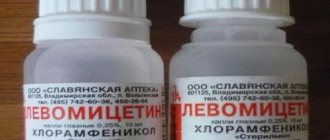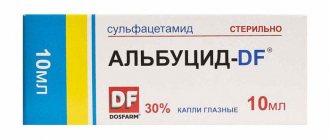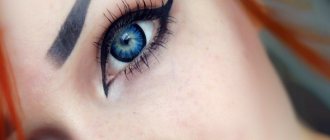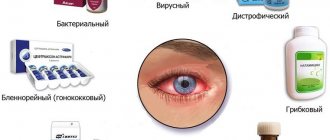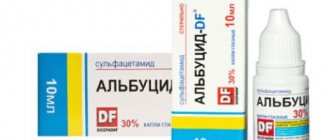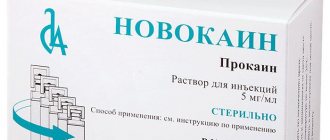127
Author of the article
Tsareva Elena Vladimirovna
Reading time: 11 minutes
A A
The cause of conjunctivitis can be any external influence, including dirty hands, cosmetic samples in stores, or contact with a sick person. But any manifestation of the disease requires immediate contact with a doctor, who can determine the type of conjunctivitis and prescribe appropriate treatment. Albucid is considered one of the most used drugs for the disease.
- Description and composition of the drug
- Medicinal properties and principle of action
- Indications
- Contraindications
- Reaction and side effects
- Preparation
- Features of use in adults
- Use in children
- For different types of illness
- Price and analogues
- Conclusion
Description and composition of the drug
Albucid is an antibacterial eye drop that is aimed at eliminating various types of bacteria. Ophthalmologists often prescribe them to both adults and children for various eye diseases, including conjunctivitis.
Currently, this medicine is available in the form of transparent drops, packaged in sterile plastic bottles of 5 or 10 ml, equipped with a dropper. The main active ingredient of Albucid is sulfacetamide, which is contained in 1 ml of the drug in an amount of 20 mg. Auxiliary components are sodium thiosulfate, hydrochloric acid and purified water.
What kind of runny nose is treated with albucid?
The answer to the question of what is the etiology of a runny nose is given by the doctor. For example, the drug will not cope with allergic rhinitis or rhinitis caused by viruses, since it is not an antihistamine or antiviral medicine. Albucid for the common cold is not prescribed at the initial stage of the disease, when nasal discharge is caused by the activity of viruses. Prolongation of the course of rhinitis (sinusitis) signals the activation of bacterial infections, then its use becomes justified and has an effect. Against this background, signs of bacterial runny nose appear as follows:
snot discharge from the nose is foul-smelling, and its consistency is dense and thick; the snot is colored in greenish-yellow, green shades; the drugs used for therapy are powerless.
The increased effectiveness of albucid is due to the fact that it suppresses the proliferation of bacteria. Its advantage is that pathogenic organisms are not resistant to it. Thus, the drug is an alternative (in some cases) to antibiotic agents, which in nasal drop compositions suppress only the group of bacteria intended for them. If the pathogen is different, then the antibiotic is useless. The active substance of albucid inhibits the synthesis of dihydropteroate synthetase and tetrahydrofolic acid, which are necessary for pathogenic microflora (bacterial) for reproduction.
In this way, infectious inflammation and disease are interrupted. The drug effectively destroys gram-positive and gram-negative types of colibacillus, toxoplasmoids, chlamydia, Escherichia, many cocci, actinomycetes, E. coli and other bacteria that cause a runny nose. The use of the solution for rhinitis in children has increased effectiveness. Therefore, albucid is used not only to treat the eyes, but also for a runny nose, despite the absence of direct instructions in the instructions for the drug.
However, the composition cannot be the main drug of drug therapy, since it is a local antiseptic. It should be remembered that the drug does not directly enter the bloodstream, since the drops irrigate the nasal mucosa and quickly flow into the esophagus. Therefore, it is often impossible to create the required concentration of a substance in a local area of the mucous membrane for a long time; it does not penetrate deeply and does not treat the entire surface. In addition, albucid does not resist, for example, Pseudomonas aeruginosa and some other bacteria, which are also causative agents of rhinitis. Before using the medicine (especially for children), you should always know what bacteria is causing the runny nose and whether it is sensitive to sodium sulfacyl.
Medicinal properties and principle of action
Albucid begins to act immediately after penetration into the mucous membrane and tissue of the eye, as it is absorbed into the systemic bloodstream through the inflamed conjunctiva of the eye.
The drug belongs to the group of sulfonamides, has a wide spectrum of antimicrobial action and is used primarily in the treatment of infectious and inflammatory eye diseases that are provoked by pathogenic microflora that are sensitive to the components of the drug. These include blepharitis, conjunctivitis, keratitis and others.
Expert opinion
Ermolaeva Tatyana Borisovna
Ophthalmologist of the highest category, Candidate of Medical Sciences
The active component of the drug stops the proliferation of pathogens, while providing a bacteriostatic effect.
Albucid is able to suppress the action and further reproduction of organisms such as streptococcus, staphylococcus, gonococcus, E. coli, chlamydia and others. It can act as first aid or a means of prevention for various types of conjunctivitis, which are often diagnosed by ophthalmologists in patients.
Can sodium sulfacyl be dripped into the eyes with lenses?
Contents [Show]
Sulfacyl sodium is an antimicrobial drug. In ophthalmology it is intended for topical use. Used in the treatment of infectious and inflammatory eye diseases (corneal ulcers, conjunctivitis, keratitis, etc.).
This remedy differs from other drugs in its extensive availability in pharmacies and low price, but due to the widespread use of antibacterial drugs, pathogens are increasingly becoming resistant to the effects of sodium sulfacyl. The drug is also known as Albucid.
Sulfacyl sodium is available in the following versions:
- in the form of a 30% solution (in 1 ml/0.3 g of sulfacetamide solution);
- in the form of a 20% solution (in 1 ml/0.2 g);
- powder per package 3 g.
The drug also consists of excipients:
- Water for injections;
- Sodium thiosulfate;
- Hydrochloric acid.
The drug is produced in volumes of 5 or 10 ml, in polyethylene bottles equipped with a dropper and a 1.5 ml dropper tube.
Internal hemorrhage in the retina. Symptoms and signs
How to treat dry eye syndrome? The answer to this question is here
Sulfacetamide is part of the group of sulfonamides; it interferes with the development of pathogenic microbes (has a bacteriostatic property). These microbes include :
- Gram-negative and gram-positive bacteria;
- Streptococci;
- Shigella;
- Pneumococci;
- Escherichia coli;
- Gonococci;
- Chlamydia;
- Actinomycetes;
- Toxoplasma and many others.
After instilling drops into the eyes, sodium sulfacyl begins to act, providing an antiseptic effect. The drug is practically not absorbed, and for this reason, it can enter the systemic circulation in very insignificant doses. This can mainly occur due to the drug entering the nasolacrimal duct or the inflamed mucous membrane of the eye.
Sulfacyl sodium eye drops are used to treat inflammatory processes in the anterior parts of the eyes (purulent corneal ulcers, eye lesions with chlamydia, blepharitis, conjunctivitis and blenorrhea in newborns.) Sulfacyl is used to treat eye diseases caused by microorganisms sensitive to the effects of sulfacetamide.
The drug can also be used for prophylactic purposes, to prevent inflammation of the eyes as a result of exposure to various unfavorable factors (sand, dust, foreign bodies, etc.).
30% Sulfacyl sodium can be used to treat only adults, and 20% is used to treat children. One or two drops of the drug are usually instilled into each eye, and the procedure is performed 3-6 times a day. As the inflammatory process of the eye subsides, the frequency of administration should be gradually reduced. The course of treatment is prescribed by the attending physician.
For newborns, as a preventive measure, the drug is instilled twice into each eye, 2 drops, after birth and 2 hours after.
The drug should not be prescribed to people with hypersensitivity to the components included in Sulfacyl sodium.
In general, the drops are well tolerated, but in rare cases, symptoms of irritation (swelling of the eyelids, redness of the eyes and itching) are observed. If such symptoms appear, the sulfacetamide solution must be used in a weaker concentration.
An overdose can result from instilling the drug into the eyes too often.
Symptoms of overdose appear in the same way as symptoms of eye irritation, only more pronounced (lacrimation, itching, sensation of a foreign body in the eye, as well as pain and burning).
In cases where these symptoms occur, it is necessary to reduce the frequency of taking the drops, using a solution with a lower concentration.
It is not recommended to use sodium sulfacyl together with agents that have an unstable pH value (kN 3-4). Due to its chemical properties, the drug is not compatible with products containing silver salts.
With simultaneous use of the drug with Anestezin, Dicaine and Novocaine, the bacteriostatic properties of Sulfacil are reduced . The toxicity of the drug increases due to its use with Diphenin, para-aminosalicylic acid and salicylates.
See the instructions for ophthalmoferon. Pharmacological action and method of administration
You can learn about the treatment and prevention of vitreous destruction at this address
Read the instructions for solcoseryl ointment at this link:
Drops should be instilled into the eye, where signs of inflammation are less pronounced. Drops should be warmed to body temperature before use, this will reduce the likelihood of side effects. In patients who are hypersensitive to carbonic anhydrase inhibitors, sulfonylureas, thiazide diuretics and Furosemide, hypersensitivity to Sulfacyl sodium may occur.
If the patient uses contact lenses, then if symptoms of eye inflammation occur, they should be stopped or removed before each use of the drug. You can reinstall the lenses 20 minutes after the procedure.
Analogues of the drug Sulfacil sodium are :
- Sulfacyl sodium MEZ;
- 20% sodium sulfacyl solution;
- Sulfacyl sodium Vial;
- Sulfacyl sodium bufus;
- Sodium sulfacetamide;
- Sulfacetamide.
The drug should be stored at a temperature of 8-15 degrees, out of reach of children and out of reach of light. Once opened, the bottle can be used for 4 weeks.
Shelf life of Sulfacyl sodium is 2 years.
The ophthalmic drug Sulfacyl sodium is an updated name for Albucid drops, which were widely used in the treatment of inflammatory eye diseases several decades ago. The parallel name of the drug is sulfacetamide. The active component is sodium sulfacetamide monohydrate, which is effective in the treatment of various types of infections:
- streptococcal;
- colibacillary;
- gonococcal;
- pneumococcal.
The auxiliary components are water for injection, sodium thiosulfate, which performs an antihistamine function, and hydrochloric acid (a preservative component).
Sulfacyl sodium eye drops
The drops are a colorless, homogeneous liquid (20% sodium sulfacetamide solution) with a weak chemical aroma. Release form: a drug for instillation in sealed PE tubes with a capacity of 1.5, 5, 10 ml, equipped with a dosage cap. On the shelves of pharmacies you can find Sulfacyl sodium drops from one. The medicine belongs to the category of budgetary pharmacological agents. Depending on the volume of the tube, the price of drops varies from 70 to 130 rubles/piece. It is available without a prescription, but it is not advisable to prescribe these drops yourself: the drug has side effects.
Sulfacetamide therapy has no age restrictions. As a prophylactic agent, it is permissible to prescribe the drug even to infants (to prevent purulent inflammation of the mucous membranes of the visual organ - blenorrhea). The drug is prescribed with caution in the treatment of inflammatory processes in the organ of vision in pregnant women and nursing mothers. Currently, there is insufficient information about the effects of sodium sulfacyl components on the embryo during gestation.
Sulfacyl sodium is used for inflammation of the conjunctiva
The drug demonstrates good results in the treatment of the following infectious and inflammatory eye pathologies:
- Inflammation of the conjunctiva (outer layer of the eye). Conjunctivitis can develop due to the influence of various factors: infection in the organ of vision due to neglect of hygiene rules, the action of a certain irritant (allergic conjunctivitis), eye fatigue, metabolic disorders, non-compliance with the rules for using contact lenses, etc.
- Inflammation of the cornea (keratitis) of traumatic or infectious origin. Sulfacyl sodium is effective both for superficial keratitis, when inflammation affects only the upper layer of the cornea, and for deep keratitis, when its inner layers are affected.
- Ulcerative keratitis, which occurs as a result of injuries to the visual organ (mechanical, chemical).
- Inflammation of the edges of the eyelids (blepharitis) caused by the penetration of Staphylococcus aureus into the tissues of the eye. The drug is prescribed for different types of blepharitis - ulcerative, scaly, meibomian, rosacea.
Due to its structural features, sodium sulfacyl is characterized by rapid penetration (absorption) into the tissues of the visual organ. When instilled, the maximum concentration of the active substance is observed in the first half hour after instillation. Remaining liquid remains in the eye tissues for a maximum of 4 hours after using the drops. In case of damage to the outer layer of the cornea, the absorption of the active component is accelerated.
Sulfacyl sodium is characterized by rapid penetration into the tissues of the visual organ
Contraindications and side effects
Treatment of eye inflammation with sodium sulfacyl is not recommended for people with hypersensitivity to substances of the sulfonamide group. Often, such patients simultaneously have increased susceptibility to thiazide diuretics, furosemide, and carbonic anhydrase inhibitors. Side effects after instillation may include irritation of the eye tissue, expressed in swelling, redness, and sometimes itching and severe burning. In case of adverse reactions, it is better to suspend the course of treatment with drops until consultation with an ophthalmologist. If side effects occur, sodium sulfacyl is prescribed in a lower concentration or replaced with other eye drops.
The pharmacological properties of sodium sulfacyl are reduced with simultaneous use of drugs containing silver salts. Parallel use of procaine and tetrocaine reduces the bacteriostatic properties of both drugs.
The main analogue of sulfacetamide is Ophthalmoferon eye drops
If sodium sulfacyl is prescribed during therapy, it should be replaced with a drug of similar action only as prescribed by the attending physician. The main analogue of sulfacetamide is Ophthalmoferon eye drops (the active substance is interferon alfa-2b). Oftalmoferon is characterized by a wider range of indications for use and a higher (almost 3 times higher) cost.
The duration of treatment with Sulfacyl sodium depends on the degree of inflammation and is determined by the attending physician.
Frequency of use for adults: maximum 6 times a day, 1-2 drops per instillation. To prevent the occurrence of blennorrhea in infants (prescribed if the baby’s mother has gonorrhea), the drug is instilled every 2 hours on the first day after birth.
How to use sodium sulfacyl - instill into the conjunctival sac
The method of using the drug is instillation into the conjunctival sac (the area between the eyeball and the lower eyelid).
- Pull the edge of the eyelid and fix it with your fingers to form a “pouch” where the medicine will fall.
- Carefully bring the tube to the eyeball and, without touching the surface with the cap, squeeze out the required number of drops.
- Close your eye and gently massage the eyeball through the closed eyelid. This will help the drops to be evenly distributed over the entire area of the eye.
- To prevent drops from getting into your sinuses, apply pressure to the inner corner of your eye after instillation. Contact lenses can be put on twenty minutes after instillation.
It is worth noting that sodium sulfacyl is used not only in ophthalmology. Some pediatricians recommend it for the treatment of acute otitis media and chronic runny nose in children. However, instillation of the drug into the nose or ears is permissible only as prescribed by a doctor; it is better to treat a runny nose at home using other means.
Patients who have tried Sulfacyl sodium drops on themselves, among the positive aspects, highlight the low price of the drug, its availability in pharmacies, and the possibility of prescribing it to small children. Some consumers consider the negative aspects of the drug to be its “aggressiveness” (burning sensation and feeling of dryness of the eye after instillation), as a result of which they are afraid to use it in children.
Sulfacyl sodium may cause a burning sensation in the eyes
Composition and release form
Eye drops 20% (sulfacetamide content 0.2 g in 1 ml solution) or 30% (sulfacetamide content 0.3 g in 1 ml solution).
Excipients: sodium thiosulfate; hydrochloric acid; water for injections.
Available in plastic dropper bottles of 5 or 10 ml.
pharmachologic effect
Sulfacyl sodium eye drops have a bacteriostatic effect on gram-positive and gram-negative bacteria, including streptococci, pneumococci, Escherichia coli, gonococci, chlamydia, and actinomycetes.
When instilled, sodium sulfacyl eye drops act predominantly locally, providing an antibacterial effect. A small amount of the drug can be absorbed and enter the systemic circulation.
Indications for use
Sulfacyl sodium eye drops are used to treat infectious and inflammatory eye diseases (conjunctivitis, blepharitis, gonorrheal eye diseases, purulent corneal ulcers), caused by bacteria sensitive to the action of the drug; also used for the prevention of blenorrhea in newborns.
Contraindications
The drug is not prescribed to patients with hypersensitivity to the components of the drug.
Directions for use and doses
Adults are prescribed a 30% solution of the drug, children are prescribed a solution with a concentration of 20%.
The drug is instilled into the conjunctival sac of the affected eye, 2-3 drops from a dropper bottle every 4-5 hours.
Side effect
In some cases, the drug may cause local irritation in the form of itching and redness of the eye, swelling of the eyelid. When these symptoms appear, the use of the drug in lower concentrations is indicated.
Overdose
An overdose of the drug can occur if it is used too often. Manifests itself in the form of symptoms of eye irritation (swelling of the mucous membrane of the eye, itching, swelling of the eyelid). If symptoms of overdose occur, you should take the necessary pause and then continue treatment using a solution of lower concentration.
Special instructions and precautions
If the patient uses soft contact lenses, they should be removed before using the drug. You can use contact lenses again 15-20 minutes after instillation.
Sulfacyl sodium eye drops should not be prescribed simultaneously with topical use of drugs containing silver salts.
In patients with a history of hypersensitivity to sulfonylurea derivatives (glibenclamide), thiazide diuretics (hydrochlorothiazide), and furosemide, increased sensitivity to sodium sulfacyl may be observed.
When using the drug for the first time, you should pierce a hole in the applicator bottle. To do this, screw the cap of the bottle tightly. Before instilling eye drops, the bottle should be held in the palm of your hand to warm the solution to body temperature.
After opening the bottle, eye drops can be used for 4 weeks, after which it is necessary to replace the bottle with the solution with a new one.
After using the drug, the tightly screwed bottle with the solution is stored at a temperature of 8-15 ° C in a place protected from light.
Lutein-Complex
To support vision during intense visual stress, computer work and the prevention of age-related eye diseases.
Go to the drug page
Lutein Forte
For complex treatment of AMD, glaucoma, cataracts, complicated myopia and in the postoperative period, with the goal of a speedy recovery.
Go to the drug page
Lutein-Complex Children's
To protect children's vision when working at a computer and intense workload at school.
Go to the drug page
Anthocyanin Forte
For complex treatment and vision support in patients with diabetes and protection of eye blood vessels.
Go to the drug page
• Sulfacyl sodium
Sulfacyl Sodium - (the same drug is called “Albucid”) - a popular drug for the local treatment of inflammatory eye diseases (conjunctivitis, keratitis, etc.).…
Indications
Albucid is used for the following diseases:
- Infectious and inflammatory diseases of the anterior part of the eyes.
- Conjunctivitis.
- Barley.
- Blepharitis.
- Keratitis.
- Purulent lesions of the cornea.
- Damage to the eyelids of various origins.
- Prevention of blenorrhea in newborns.
- Gonorrheal diseases in adults and newborns.
- The medicine can be used as a means of preventing eye infection during the rehabilitation period after eye surgery.
Expert opinion
Ermolaeva Tatyana Borisovna
Ophthalmologist of the highest category, Candidate of Medical Sciences
The drug is effectively used in the treatment of bacterial conjunctivitis, but at the same time it may be ineffective in other forms and even cause an increase in the inflammatory process. For example, for viral conjunctivitis, the drug is used after a secondary eye infection is detected.
How can Albucid be replaced in the treatment of conjunctivitis?
If it becomes necessary to replace albucid with any other drops, you should choose ophthalmic solutions that have a wide spectrum of antibacterial action. Such medications include:
- Oftadek.
- Tobrex.
- Tsipromed.
- Levomycetin.
- Phloxal.
Oftadek
Eye drops based on decamethoxin, a substance that has pronounced antiseptic and antimicrobial properties. Drops are prescribed for chlamydial lesions of the organs of vision, conjunctivitis, blepharoconjunctivitis, purulent-inflammatory processes caused by the following types of pathogens:
- Pneumococci.
- Staphylococci.
- Gonococci.
- Streptococci.
- Enterobacteriaceae.
- Meningococci.
The medication is also effective against eye infections with Candida fungi and some viruses.
Side effects can manifest themselves in the form of pain, itching, swelling of the eyelids, increased tear production, and redness of the conjunctiva. Contraindication: hypersensitivity.
Tobrex
The medicine contains tobramycin, a substance that has antibacterial properties and is effective for eye diseases caused by:
- Staphylococcus.
- Streptococci.
- Klebsiella.
- Enterobacteria and other pathogens.
The medication is prescribed for conjunctivitis, blepharitis, keratitis, iridocyclitis, keratoconjunctivitis of bacterial origin.
After administering the medicine to the eyes, itching, swelling of the eyelids and conjunctiva may occur. The product should not be used if you are highly sensitive to tobramycin.
Tsipromed
Drops for the treatment of ophthalmic diseases - uveitis, keratitis, conjunctivitis, dacryocystitis. The pharmacological solution is developed on the basis of tsipromed, a substance that belongs to the fluoroquinolone group of antibiotics and has antibacterial as well as bactericidal properties. Tsipromed is effective for diseases caused by:
- Klebsiella.
- Staphylococcus.
- Streptococci.
- Chlamydia and other pathogens.
After instillation, the medication may cause a feeling of sand, pain and itching in the eyes, hyperemia of the mucous membranes, and photophobia. The medicine cannot be used for the treatment of children under 1 year of age, with hypersensitivity, pregnancy and hepatitis B.
Levomycetin
The medication in the form of eye drops contains chloramphenicol, which has antimicrobial properties and has a bacteriostatic effect. It is active against the following pathogens:
- Streptococci.
- Salmonella.
- Staphylococci.
- Klebsiella.
- Shigella and others.
Drops are prescribed to patients suffering from infectious and inflammatory diseases of the organs of vision. Caused by the pathogens listed above. Thus, this remedy is effective for conjunctivitis, keratitis, blepharitis, keratoconjunctivitis.
After instillation, the medicinal solution can cause swelling, redness and itching in the eyes, and skin rash in the eyelid area.
Levomycetin has such contraindications as pregnancy and breastfeeding, hypersensitivity, liver and kidney failure, fungal infections of the epidermis, eczema.
Contraindications
The main contraindication to the use of Albucid is the patient's hypersensitivity to sulfacetamide and other drugs containing sulfonamide. The drug is also not recommended for use in patients allergic to thiazide diuretics. These drops are used with caution during pregnancy and lactation and only after consultation with a doctor.
Wearing contact lenses also cannot be combined with taking Albucid, so you should avoid contact lenses during the treatment period.
Reaction and side effects
Immediately after instilling the drug into the eyes, slight tingling, burning and even itching may appear, but this does not require discontinuation of the drug. Often, after using the ophthalmic drug Albucid, the patient may experience some side effects and persist during the entire course of treatment:
- Temperature increase.
- Swelling of the conjunctiva.
- Tearing.
- Itching and burning in the eyes.
- Skin rash.
Expert opinion
Ermolaeva Tatyana Borisovna
Ophthalmologist of the highest category, Candidate of Medical Sciences
If symptoms persist for a long time, you should immediately stop using the drug and consult an ophthalmologist.
What can a mother do before visiting a doctor?
Drops can be used for purulent eyes in a newborn, but only once and before visiting a doctor. If it has been noted that the newborn’s eyes are purulent, the following can be done at home:
- rinse eyes with clean water;
- rinse your eyes with chamomile decoction (1 tablespoon per 200 ml of water) or Miramistin solution - any product is diluted with boiled water in a 1:1 ratio;
- drop 1 drop of albucid into each eye.
Despite the fact that Albucid is useless for some diseases, its use before visiting a doctor will slightly slow down the progression of the pathological process
The mother must measure the child’s body temperature, pay attention to his sleep and behavior while awake - such data will help the doctor make a diagnosis and choose a therapeutic direction
Albucid should be present in the child's first aid kit, but its use should be careful. Without a doctor's prescription, it is permissible to instill eyes with this drug, but no more than 1 drop in each eye and twice a day. When establishing an accurate diagnosis, the pediatric ophthalmologist will give clear instructions regarding the advisability of using eye drops, the daily dosage and duration of use.
Preparation
In order to achieve a positive result from treatment with Albucid, you need to follow the instructions for its use :
Did Albucid help you with conjunctivitis?
Not really
- First of all, clean the mucous membrane of the eyes from purulent discharge, if any, using Furacilin solution or chamomile decoction.
- The drug should be slightly warmed by holding the bottle in your hands for several minutes.
- The head should be tilted back, the pupils should be raised up, and the lower eyelid should be pulled down.
- Holding the eyelid with one hand, carefully drop the indicated number of drops of solution into the conjunctival sac; the same procedure is performed with the second eye.
- Next, you need to close your eyes, preventing the drops from flowing out of your eyes. To do this, press the inner corners of your eyes with your fingertips.
- Sit with your eyes closed and your head tilted back for several minutes.
- If liquid still leaks from the eyes, carefully remove it with a napkin or cotton pad.
Expert opinion
Ermolaeva Tatyana Borisovna
Ophthalmologist of the highest category, Candidate of Medical Sciences
The dosage of the drug is prescribed by the doctor individually, depending on the severity of the disease.
Instructions for use
Note! To carry out therapeutic measures using Albucid eye drops, you must strictly follow the instructions for use. It contains recommendations for patients of different age categories
It contains recommendations for patients of different age categories.
For adults
To quickly achieve a positive result when treating with Albucid, adult patients should be treated according to the following scheme:
Wash your hands with soap and dry them with a napkin.
Clean the eyes from purulent discharge using a cotton pad or gauze folded several times and Furacilin solution
The solution can be replaced with chamomile decoction or clean warm water. Hold the bottle of medicine in your hands for two minutes to slightly warm the contents. Take a comfortable position (sit down or lie down), tilt your head back and raise your pupils up.
Carefully pull the lower eyelid with your hand and inject 1-3 drops of the medicinal solution into the conjunctival sac, without touching the tip of the bottle to the mucous membrane. Repeat the procedure for the other eye.
Close your eyelids and lightly press the inner corners of your eyes with your fingertips - this will prevent drops from flowing out.
Remove any remaining drops with a cotton pad or clean napkin. Do not rinse your eyes after the procedure.
In acute forms of pathology, the drug should be used for at least 7 days, using eye drops every 3-4 hours. The exact dosage is determined by a specialist, taking into account the severity of the disease on an individual basis.
Before use, you should check the expiration date of the medicine and the integrity of the packaging.
For children
Stay up to date! The treatment regimen for conjunctivitis in children differs slightly:
- Wash your hands thoroughly with soap and dry them.
- Wipe the child's eyes and warm the drops to a comfortable temperature.
- Place the child on a flat surface and with the thumb of your left hand pull down the lower eyelid of the little patient.
- Place 1-2 drops of the medicinal solution into the conjunctival sac and repeat the manipulation with the second eye.
- Blot closed eyelids with a clean napkin or cotton wool, without allowing the baby to rub his eyes with his hands.
- After the procedure, wash your hands.
The selection of the required dosage of the drug is carried out by an ophthalmologist, taking into account the nature of the pathology, the age of the child and the individual characteristics of his body.
Features of use in adults
For the treatment of conjunctivitis in adults, a solution of the drug Albucid 30% is prescribed. In this case, the dosage of drops depends on the severity of the disease and the degree of inflammation. For example, in acute cases of the disease, it is recommended to instill 2-3 drops into each eye up to 6 times a day. As symptoms decrease and the patient's condition improves, the dosage is gradually reduced. After the symptoms of the disease completely disappear, the instillation of the drug is stopped.
Review of eye drops for newborns
Unfortunately, there are not many ophthalmic agents that could be safely used to treat children under 1-2 years of age. Most drug manufacturers, for one reason or another, refuse to study the long-term effects of their drugs on newborns. As for eye drops specifically, today on pharmacy shelves you can find only a few products whose safety and effectiveness in treating infants has been 100% proven.
Albucid
Albucid is a 20% solution of sodium sulfacyl (more details in the article: how to drip Albucid into the eyes of newborns?). An antibiotic with broad antibacterial action that prevents the active proliferation of microorganisms in the ocular mucosa. Can be used to treat children from the first days of life. Recommended dosages are 2-3 drops, up to 6 times a day (or as prescribed by a pediatric ophthalmologist). The average price per bottle ranges from 100 rubles.
Vitabact
A broad-spectrum antiseptic drug, used with equal success in the treatment of all types of ophthalmological diseases. It combines well with other medications and has excellent anti-inflammatory properties, which is why it is often used to prevent complications during the postoperative rehabilitation period.
Can cause side effects in the form of temporary loss of visual acuity. No other negative consequences of using Vitabact have been identified, which makes it possible to prescribe this drug to newborns. The dosage of the drug is selected individually, depending on the patient’s age and the severity of the pathology being corrected. The course of treatment is no more than 10 days. The cost of the drug is from 350 rubles per package.
READ ALSO: Vitabact eye drops: instructions for use, indications for children
Oftalmoferon
A combined drug that simultaneously has antibacterial, antiviral and antihistamine properties. Good anesthetic. Can act as an immunomodulatory and regenerating agent. Excellent fight against inflammation. Due to the unique combination of active ingredients, despite its effectiveness, it remains absolutely safe, which is why it is actively used in the treatment of ophthalmic pathologies in newborns.
The recommended dosage for the youngest patients is 1 drop in each eye up to 8 times a day. If necessary, a five-day course of treatment can be extended without risk up to a month, especially since one bottle of the product (and it costs only 300 rubles) is quite enough for this.
Use in children
When treating conjunctivitis in children, ophthalmologists recommend the use of Albucid 20% eye drops. In children, conjunctivitis often occurs due to poor personal hygiene. Only an ophthalmologist can prescribe the correct dose of the drug after examining the child and his eyes. Albucid is prescribed according to the age of the child and the course of the disease. In the acute stage of the disease, it is recommended to instill 2 drops into each eye 2 to 6 times a day.
Some parents use the drug as a treatment for the common cold, but this method is not justified, and Albucid is not so effective in this case. The drug is mainly indicated for the treatment of childhood eye infections.
Expert opinion
Ermolaeva Tatyana Borisovna
Ophthalmologist of the highest category, Candidate of Medical Sciences
Before using Albucid in newborns, you should consult your pediatrician. Self-medication with this drug is contraindicated.
Where is Albucid used?
The main object of influence is the visual organs. Dosage forms allow it to be taken topically by drops, aerosols and injections. The substance effectively cures:
keratitis (the cornea becomes inflamed); conjunctivitis (the mucous membrane becomes inflamed); blepharitis (the eyelids become inflamed), etc.
The drug prevents the development of a dangerous infectious disease in newborns - gonoblennorrhea. The substance drips onto the genitals of infant girls and into the slits of the eyes of all infants.
During postoperative rehabilitation, it is used to suppress the development of infections. For a reliable bacteriostatic effect of the composition, a sufficient local concentration is required. This explains its successful use in ophthalmology as drops. The substance accumulates in large quantities in the eye tubules and destroys infections. At the same time, the bacteriostatic versatility of the drug has expanded its use in the treatment of runny noses, although the instructions for albucid do not indicate such use.
For different types of illness
Albucid eye drops are not always prescribed by a doctor, but depending on the form of conjunctivitis and its stage:
- Viral. It occurs as a result of the penetration of an adenovirus into the body and requires treatment with antiviral drugs. In addition to eye ointments, oral antiviral drugs, Albucid eye drops are also prescribed. As prescribed by the doctor, they can be supplemented with other drops that have a positive effect on the conjunctiva.
- Bacterial. Can be treated with a 20% Albucid solution. This treatment should be supplemented by applying a special ointment and washing the eyes with disinfectants, for example, chamomile infusion. This disease is characterized by the release of pus, so the eyes should first be cleaned with a moistened cotton pad.
- Allergic. Albucid is rarely used for this disease. It is prescribed if a secondary infection is observed, for example, an allergic reaction against the background of an existing infectious disease or an infection introduced from outside.
- Purulent. It most often develops when a foreign body or other pyogenic infection enters the mucous membrane of the eyes. If the infection is removed in time, no special treatment will be required; it is only important to eliminate the remaining pus with a disinfectant such as a solution of potassium permanganate or chamomile. If the purulent discharge increases each time, and lacrimation is added to it, then you should use Albucid and a special ointment. It is necessary to clean the mucous membrane before instilling Albucid and follow the dosage to avoid side effects.
Expert opinion
Ermolaeva Tatyana Borisovna
Ophthalmologist of the highest category, Candidate of Medical Sciences
In addition, it is necessary to take into account the individual characteristics of the patient, for example, sensitivity to the components of the drug.
Price and analogues
The average price for Albucid eye drops is 45-50 rubles. The cost of the drug also depends on the concentration of the active ingredient and the volume of the bottle.
Analogs of the drug include eye drops Tobrex, Levomycetin, Tetracycline and others.

